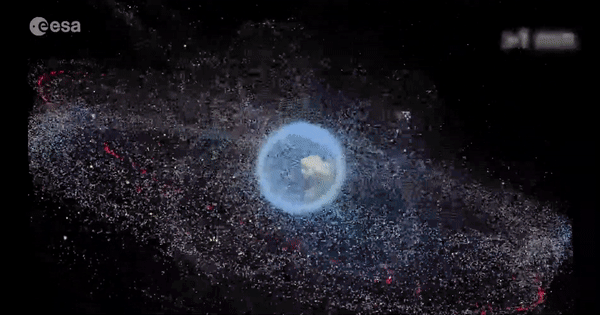The European Space Agency Is Sending a Robot to Hug Junk Out of Space
The mission, set to launch in 2025, will be the first to remove a piece of debris from Earth’s lower orbit
/https://tf-cmsv2-smithsonianmag-media.s3.amazonaws.com/filer/62/6a/626a5cda-7222-4389-8748-1ab84eb5cce1/clearspace-1_with_captured_vespa_copy_crop.png)
For all its vastness, space is notoriously lacking in landfills.
That means a lot of the stuff we humans send out there—be it satellites or rocket parts—ends up indefinitely adrift in the cosmos after its job is done. No longer useful for missions and too cumbersome to move or destroy, space debris has spent the last six decades accumulating around our planet like a shroud of schmutz. And this halo of junk is more than an extraterrestrial eyesore: Its mere presence endangers active satellites and spacecraft.
As more probes are pushed into space, the congestion in Earth’s lower orbit is only increasing. But if all goes according to plan, humankind may soon have a way to combat that troubling trend.
In a statement released earlier this month, the European Space Agency announced plans to launch a tentacled robot into space that will remove a piece of abandoned junk from orbit. The mission, called ClearSpace-1, is quite the emotional rollercoaster. After enveloping a 265-pound hunk of debris called Vega Secondary Payload Adapter (VESPA) in a four-armed hug, the robot will boomerang back to Earth—a death dive that will burn up both devices in the atmosphere.

Of course, that means there’s no encore act for ClearSpace-1. But if the mission is successful, ESA officials say in the statement, it will be the first to pluck actual debris from orbit. Ideally, they say, it would someday pave the way for a machine capable of multiple captures, sequentially ejecting each object into the atmosphere, reports Hannah Devlin at the Guardian.
Designed by Swiss startup ClearSpace, the robot will begin development in earnest next March, with a total mission budget estimated at $133 million, Devlin reports.
And the robot isn’t the only trash-collecting space tech being tested. Some groups are trying out snare tactics that include nets and harpoons; others are toying with the idea of destroying debris with lasers or rocket engines, reports Neel V. Patel for MIT Technology Review. No matter the modus operandi, all are eager to grapple with the growing issue of cosmic garbage.
“Imagine how dangerous sailing the high seas would be if all the ships ever lost in history were still drifting on top of the water,” ESA Director General Jan Wörner says in the statement. “That is the current situation in orbit, and it cannot be allowed to continue.”
Of the 4,500 satellites currently bopping around Earth, only about 1,500 are active. The rest constitute dangerous clutter. Joining them are about 20,000 other pieces of space junk that are at least four inches wide—about the size of a softball. Those are the ones big enough to be detectable from the ground; many millions more, researchers estimate, float invisibly in the gaps between.
As they orbit the Earth, objects can reach speeds of 17,500 miles per hour, fast enough to damage a wayward satellite or spacecraft. In 2016, a tiny piece of space debris gouged a quarter-inch hole of glass out of one of the windows on the International Space Station (ISS). The culprit, researchers suspect, was probably a paint chip or fragment of metal, no more than a few thousandths of a millimeter across. Had it been much bigger, an entire appendage of the ISS could have been shattered to pieces.
“This is the right time for such a mission,” ClearSpace CEO Luc Piguet says in the statement. “The space debris issue is more pressing than ever before.”
That said, grabbing garbage out of space also doesn’t address the root of the issue: The unsustainable practices of modern space activity. As such, future efforts need to be about more than just cleaning up what’s already up there, Luisa Innocenti, who heads ESA’s Clean Space initiative, says in the statement. “We need to develop technologies to avoid creating new debris.”
/https://tf-cmsv2-smithsonianmag-media.s3.amazonaws.com/accounts/headshot/10172852_10152012979290896_320129237_n.jpg)
/https://tf-cmsv2-smithsonianmag-media.s3.amazonaws.com/accounts/headshot/10172852_10152012979290896_320129237_n.jpg)